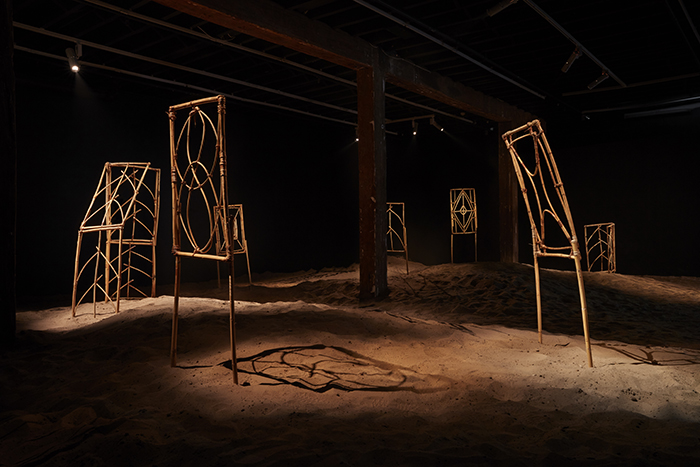The indigenous artist’s work is an indictment of resource imperialism that has reshaped Bourgainvillean geography, writes Micheal Do
Focusing on the Australian-run Panguna mine – once the largest open-pit mine in the world – Reclamation burrows deep into the wounds of the Autonomous Region of Bougainville of Papua New Guinea and gives poetic form to the intersecting realities of Bougainvilleans as they seek to rebuild a society ravaged by mining interests. Those interests resulted in the displacement of thousands of refugees throughout Oceania, including Taloi Havini’s family.
In this, her first Australian solo exhibition, the Bougainville-born, Sydney-based artist takes a less-is-more approach, exploring this history through a suite of eloquent and atmospheric works suffused with anguish and longing.
Three wallpaper prints surround the gallery entrance: Copper mineral #1, detail. Habitat and Copper mineral #2, detail. Habitat (both 2018–19) are shots of copper ore leaching into azure water taken from her videowork Habitat (2018), while Bougainville District Map, Department of Direct Administration, October 1965 (2019) depicts a map of the boundaries of Bougainville Island that have been redrawn and relabelled by an Australian administration. Through these visual metaphors, Havini sets the symbolism of toxic copper contaminating a water supply beside the reshaping of the island’s geography to serve as an authoritative indictment of the resource imperialism Panguna has imposed on Bougainville’s environment and first nation systems of political and social organisation.
In an adjoining room, the four-channel Habitat serves as a powerful elegy to people affected by the island’s civil war. Narrated by Bougainvillean community leader and activist Kuntamari Crofts, of the Barapang Matonaru Clan of South Nasioi, in her native tongue – one of 19 languages spoken on the island, and one also spoken by Havini – the video alternates between using all four channels to display vast scenes of the open-cut mine or wetlands, and showing archival footage of the civil war and Bougainvillean protests simultaneously on separate channels, setting up dynamic contrasts. Stitched together into a loose narrative, the scenes of lush scenery and violence tell of the years leading up to, and following, 1988, when the activities of Panguna occasioned a secessionist rebellion that swept across the region, resulting in over 15,000 deaths. Lingering shots of the terrain serve to illuminate a landscape seeded with tragedy, bitterness and destruction, revealing the disquieting truths that speak of Australia’s often violent and imperialist agenda in the Pacific.
Havini has long collaborated with female members of her Hakö community, as a means by which to extend the matrilineal systems of political, social and cultural organisation that exist on the island. The newly commissioned Reclamation (2020), an installation steeped in the rhythms and traditions of Bougainville, embodies this modus operandi. The work comprises locally sourced palm and cane constructions – collaboratively shaped, often by four to five clan members working in groups, to embody different aspects of Hakö culture, from personal totems, to private cultural ceremonies, to indigenous musical instruments – arrayed across an undulating terrain of sandy earth. In intentionally echoing the inhospitable but strangely beautiful lands depicted in the video Habitat, Reclamation is devised as a counter to the colonial maps presented elsewhere in the exhibition, offering an indigenous means of surveying Bougainville culture and stretching Western concepts of time, space and representation.
By recasting her understanding of indigenous Hakö culture and ancestral home, Havini’s works depict a society simultaneously traumatised by war yet filled with hope for its future. As Bougainville relishes the successful referendum for independence only months ago, Havini’s part-elegiac, part-polemic exhibition is a timely corrective to Australian history at large.
Taloi Havini, Reclamation, Artspace, Sydney, 17 January – 23 February 2020
From the Spring 2020 issue of ArtReview Asia
